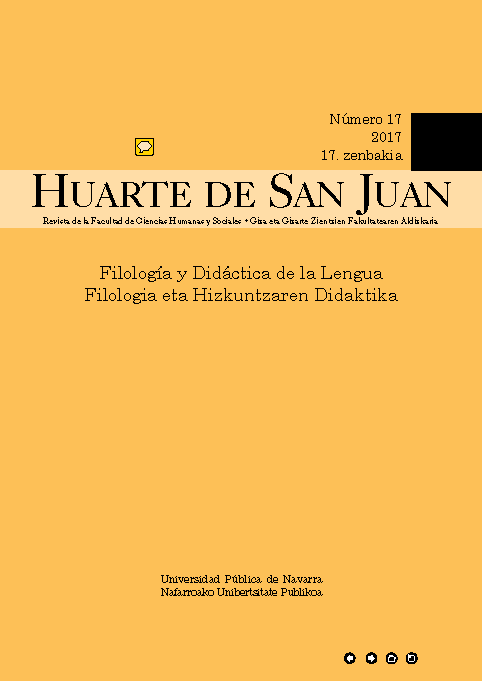Collaborative writing in the EFL Secondary Education classroom: Comparing triad, pair and individual work
Palabras clave:
Escritura colaborativa, trabajo individual, trabajo por parejas, trabajo en tríos, Educación SecundariaResumen
Este estudio analiza los beneficios de las tareas colaborativas de escritura en un contexto de 1º de la ESO. En los últimos años ha habido un incremento de investigaciones que basándose en teorías socio-cognitivas y metodologías comunicativas han examinado los beneficios del uso de la escritura colaborativa para el aprendizaje de lenguas extranjeras, aunque estos estudios son todavía escasos en las clases de Educación Secundaria en España y la mayoría han comparado los resultados de tareas realizadas individualmente frente a las realizadas en parejas. Nuestro estudio replica parcialmente un estudio realizado por Fernández Dobao (2012), y analiza la precisión, la fluidez y la complejidad sintáctica de un mismo texto realizado individualmente (n=18), en parejas (n=20) y en tríos (n=21). Los resultados sugieren que la colaboración y un número mayor de participantes benefician la precisión, la fluidez y la complejidad sintáctica. Sin embargo, los textos escritos individualmente mostraron más subordinación que los escritos de manera colaborativa.
Descargas
Citas
Alegría de la Colina, A. & García Mayo, M. P. (2007): «Attention to form across collaborative tasks by low-proficiency learners in an EFL setting», in M.P. García Mayo (ed.), Investigating Tasks in Formal Language Learning, Clevedon, Multilingual Matters, pp. 91-116.
BOE (2013) Ley orgánica 8/2013 para la mejora de la calidad educativa (LOMCE), num. 295. Reference: BOE-A-2013-12886. Retrieved from: http://www.boe.es/buscar/pdf/2013/BOE-A-2013-12886-consolidado.pdf [Last accessed: 10/12/2017]
Cumming, A. (2009): «The contribution of studies of foreign language writing to research, theories and policies», in R. Manchón (ed.), Writing in Foreign Lan-guage Contexts. Learning, Teaching and Research, Clevedon, Multilingual Matters, pp. 209-231.
Donato, R. (1994): «Collective scaffolding in second language learning», in J. P. Lan-tolf & G. Appeal (eds.), Vygotskian approaches to second language research, Norwood (NJ), Ablex Publishers, pp. 33-56.
Ellis, R. (2006): «Current issues in the teaching of grammar: An SLA perspective», TESOL Quarterly, 40 (1), pp. 83-107. Doi: 10.2307/40264512
Fernández Dobao, A. (2012): «Collaborative writing tasks in the L2 classroom: Comparing group, pair, and individual work», Journal of Second Language Writing, 21 (1), pp. 40-58. Doi: 10.1016/j.jslw.2011.12.002
Gil Sarratea, N. (2014): Collaborative writing: Product, process and students’ perceptions in Secondary School EFL writing. MA Dissertation, UPNA (unpublished). Re-trieved from: http://academica-e.unavarra.es/handle/2454/11530 [Last accessed: 10/12/2017]
Gor, K. & Long, M. H. (2009): «Input and second language processing», in W. C. Ritchie & T. K. Bhatia (eds.), The New Handbook of Second Language Acquisition, Bingley, Emerald, pp. 445-472.
Harmer, J. (2007): The Practice of English Language Teaching, 4th ed., Harlow, Pearson.
Krashen, S. D. (1985): The Input Hypothesis: Issues and Implications. London; New York, Longman.
Kuiken, F. & Vedder, I. (2002): «Collaborative writing in L2: The effect of group interaction on text quality», in S. Ransdell & M. L. Barbier (eds.), New Directions for Research in L2 Writing, Dordrecht, Springer Science and Business Media, pp. 168-188.
Manchón, R. (ed.) (2009): Writing in Foreign Language Contexts. Learning, Teaching and Research. Clevedon, Multilingual Matters.
McDonough, K. & García Fuentes, C. (2015): «The effect of writing task and task conditions on Colombian EFL learners’ language use», TESL Canada Journal, 32 (2), pp. 67-79. Doi: http://dx.doi.org/10.18806/tesl.v32i2.1208.
Memari Hanjani, A. (2015): «Collaborative revision in L2 writing: learners’ reflec-tions», ELT Journal. Doi: 10.1093/elt/ccv053.
Mulligan, C. & Garofallo, R. (2011): «A collaborative writing approach: Methodology and student assessment», The Language Teacher, 35 (3), pp. 5-10.
Long, M. H. (1985): «Input and second language acquisition theory», in S. Gass & C. Madden (eds.), Input and second language acquisition, Rowley (MA), Newbury House, pp. 377-393.
Ortega, L. (2009): «Studying writing across EFL contexts: looking back and moving forward», in R. Manchón (ed.), Writing in Foreign Language Contexts. Learning, Teaching and Research, Clevedon, Multilingual Matters, pp. 232-255.
Pica, T. (2009): «Second language acquisition in the instructional environment», in W. C. Ritchie & T. K. Bhatia (eds.), The New Handbook of Second Language Acquisition, Bingley, Emerald, pp. 473-501.
Reid, J. M. (1993): Teaching ESL Writing. Englewood Cliffs (NJ), Prentice Hall Regents.
Reichelt, M. (2009): «A critical evaluation of writing teaching programmes in different foreign language settings», in R. Manchón (ed.) Writing in Foreign Language Contexts. Learning, Teaching and Research, Clevedon, Multilingual Matters, pp. 183-206.
Richards, J. C. & Schmidt, R. (2010): Dictionary of Language Teaching and Applied Linguistics, 4th ed. Harlow, Longman.
Schmidt, R. (2010): «Attention, awareness, and individual differences in language learning», in W. M. Chan, S. Chi, K. N. Cin, J. Istanto, M. Nagami, J. W. Sew, T. Suthiwan, & I. Walker, Proceedings of CLaSIC 2010, Singapore, National Univer-sity of Singapore, Centre for Language Studies, pp. 721-737.
Stanley, J. (1992): «Coaching student writers to be effective peer evaluators», Journal of Second Language Writing, 1 (3), pp. 217-233. Doi: https://doi.org/10.1016/1060-3743(92)90004-9
Storch, N. (2005): «Collaborative writing: Product, process and students’ reflections», Journal of Second Language Writing, 14(3), pp. 153-173. Doi: https://doi.org/10.1016/j.jslw.2005.05.002
Storch, N. (2013): Collaborative Writing in L2 Classrooms, Bristol, Buffalo, Toronto, Multilingual Matters.
Storch, N. & Wigglesworth, G. (2007): «Writing tasks: The effects of collaboration», in M. P. García Mayo (ed.), Investigating Tasks in Formal Language Learning, Clevedon, Multilingual Matters, pp. 157-177.
Swain, M. (1993): «The output hypothesis: Just speaking and writing aren’t enough», The Canadian Modern Language Review, 50 (1), pp. 158-164.
Swain, M. (2006): «Languaging, agency and collaboration in advanced second language learning», in H. Byrnes (ed.), Advanced language learning: the contributions of Halliday and Vygotsky, London, Continuum, pp. 95-108.
Swain, M. & Lapkin, S. (1998): «Interaction and second language learning: Two adolescent French immersion students working together», The Modern Language Journal, 82, pp. 320-337. Doi: 10.1111/j.1540-4781.1998.tb01209.x
Vygotsky, L. S. (1978): Mind in society: The development of higher psychological processes. Cambridge (MA), Harvard University Press.
Williams, J. (2005): «Form-focused instruction», in E Hinkel (ed.), Handbook of Re-search in Second Language Teaching and Learning, Mahwah (NJ), London, Law-rence Erlbaum Associates, pp. 671-691.Chan, S. Chi, K. N. Cin, J. Istanto, M. Nagami, J. W. Sew, T. Suthiwan, & I. Walker, Proceedings of CLaSIC 2010, Singapore, National Univer-sity of Singapore, Centre for Language Studies, pp. 721-737.
Descargas
Publicado
Cómo citar
Número
Sección
Licencia
Todos los artículos son publicados bajo una licencia de uso y distribución Creative Commons (BY-NC-ND 4.0). A cada artículo se le asignará un identificador DOI.
Los autores conservan los derechos de autor y conceden a la revista el derecho de la primera publicación. Los autores podrán establecer acuerdos adicionales para la distribución no exclusiva de la versión de la obra publicada en la revista (por ejemplo, situarlo en un repositorio institucional), con un reconocimiento de su publicación inicial en esta revista. Los trabajos podrán subirse a repositorios institucionales inmediatamente tras la publicación de la revista.
Asimismo, se permite y se anima a los autores a difundir sus trabajos electrónicamente (por ejemplo, en repositorios institucionales, redes sociales académicas o en su propio sitio web).







